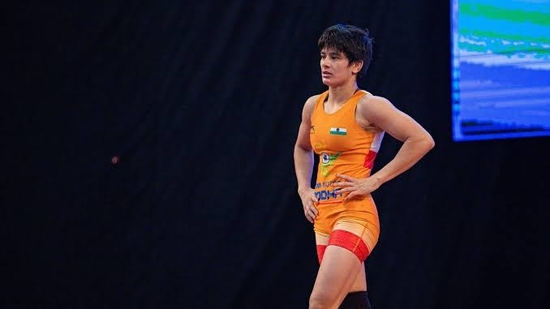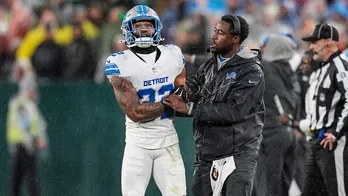With silver, Shivani Pawar becomes part of India’s wrestling elite
Shivani Pawar stood on the brink of history on Thursday night in Belgrade, with the opportunity to become the first Indian wrestler, man or woman, to win a gold medal at the U23 World Championships. It began well for Pawar too—against USA’s Emily King Shilson, who came into the 50kg final against Pawar having won every major age group competition—she scored an early takedown. But it was not to be, as King, clearly emerging as a contender for the Olympic title in Paris, threw Pawar and pinned her down in the same move for a victory by fall.

Pawar may not have made history with a gold, but the young wrestler from Madhya Pradesh joined a pretty illustrious list of Indians who have won a silver at the U23 Worlds—Tokyo Olympics bronze medallist Bajrang Punia and silver medallist Ravi Dahiya.
With Anju winning a bronze with a dominating fight on the same night, Pawar became the seventh Indian to win a medal at the U23 Worlds. Three other women wrestlers—Radhika (62kg), Nisha (65kg) and Divya Kakran (72kg) will compete for bronze medals on Saturday at the tournament in Belgrade, while Saurabh Madhukar Igave (57kg) won his quarterfinal bout on Friday in the men’s section.
Pawar’s silver came on the back of a remarkable turnaround, because she was a point away from being eliminated in the first round itself. Against Anastasiya Yanotava of Belarus in her opening bout, Pawar had looked helpless. Yanotova had rushed to 9-0. If a fighter opens up a 10-point lead in a wrestling match, the bout is stopped on account of technical superiority.
A minute left on the clock and Yanotova moved in for the kill, only to be left stunned by a swift and unexpected counterattack from Pawar who finished the match off in style with a pin.
It was the start of an exciting tournament for Pawar who emerged at the end of it as a great new find for Indian wrestling. Her counter-attacking style was on full display as she progressed in the draw, surprising her opponents with her fast, explosive bursts of speed, turning their attacks into her advantage. “It was her first big international tournament so she was a bit overawed while facing foreign wrestlers. In the first bout, she was hardly doing anything when we told her this is not the way to fight. You need to try and score points. We motivated her by saying there was nothing to fear,” said Mahavir Singh Bishnoi, one of the coaches with the Indian team in Belgrade.
In the quarter-finals, Pawar was trailing 3-6 against Tetiana Profatilova of Ukraine but now she had found her inner strength. She was completely calm as she worked Profatilova for two points and when the Ukrainian came in for her legs, Pawar launched her full counter, tossing her opponent around for six points. Now Pawar raced to ten points and she was in the semis. Here too, Pawar sprung her deceptive, counterattacking game on the reigning European U-23 champion, Maria Tiumerekova of Russia. The two were locked 4-4 when Pawar got her second pin of the tournament on a counter.
From football to wrestling
Unlike Punia, Dahiya or most of India’s globally successful wrestlers, Pawar is not from Delhi or Haryana. She comes from a farming family from a village called Umreth in Madhya Pradesh, roughly 30km from the town of Chhindwara.
In school, Pawar loved playing football, but her football coach thought she would be better suited to wrestling. “She was 12 years old when she started wrestling and there was something in the sport that attracted her,” said her mother Pushpa.
During a tournament in Chhindwara, former national champion turned coach Fatima Bano spotted her and got her enrolled in a state programme. Pawar moved to Bhopal to join the MP Khel Academy.
“At first it was difficult to manage money for her training and diet but we never stopped her,” Pushpa said. “We have a small farm of three acres. She was then fighting in dangals and started earning prize money from dangals and used that money for her training.
“There were neighbours and other people who would tell us we should not allow our girl to wrestle. Shivani loves the sport so much that she told me that ‘I will never talk to anyone who tells me to leave wrestling’.”
Bano knew she had a special talent to mould. She had seen women’s wrestling grow in India from a point when there wasn’t even a women’s national championship. Bano competed in the first senior nationals for women in 1997 and won a gold medal.
“I fought in 68kg category and Sonika Kaliraman and Gursharan Kaur were in my category. It was the beginning of women’s wrestling in India and we hoped that it will be introduced in the Olympics some day. I played in three more nationals and then because of injury I had to leave. I took up coaching,” said Bano. “I told Shivani about the Olympics and that she can fulfil my dream. She told me that she will do everything possible to compete in 2024. She was hooked on the competition in Tokyo.” The thing that caught Bano’s eye when she first saw Pawar was her quick and fluid movement. It also made it easy for Bano to teach her technique.
“Her strength is her counter-attacks and she can really surprise her opponents. But she is also good at initiating attacks,” said Bano, who now runs her own academy in Bhopal. “The competition in her category is tough in nationals but she did well to win the title in Under 23-nationals this time. She has progressed well and this title will give her a lot of confidence towards her goal of competing in Paris.”
Disclaimer: The copyright of this article belongs to the original author. Reposting this article is solely for the purpose of information dissemination and does not constitute any investment advice. If there is any infringement, please contact us immediately. We will make corrections or deletions as necessary. Thank you.







